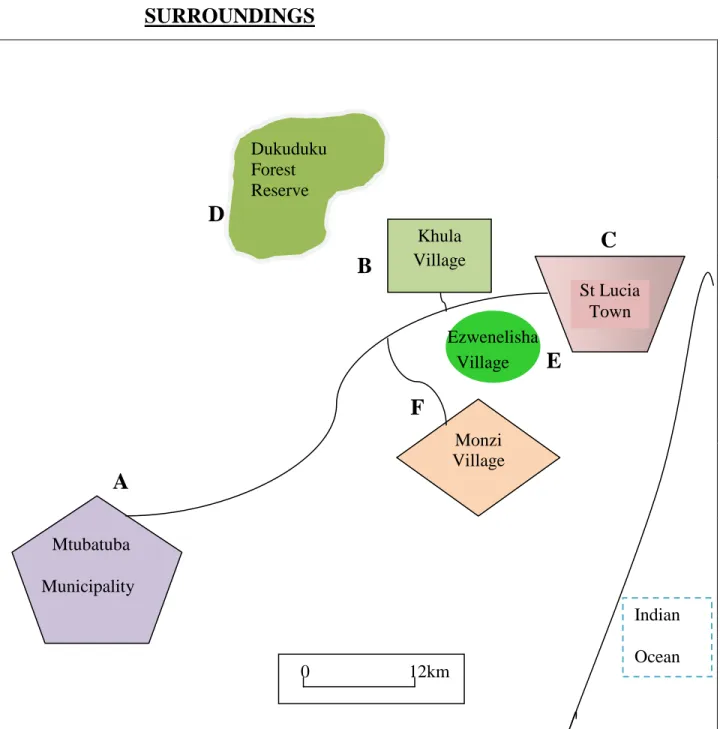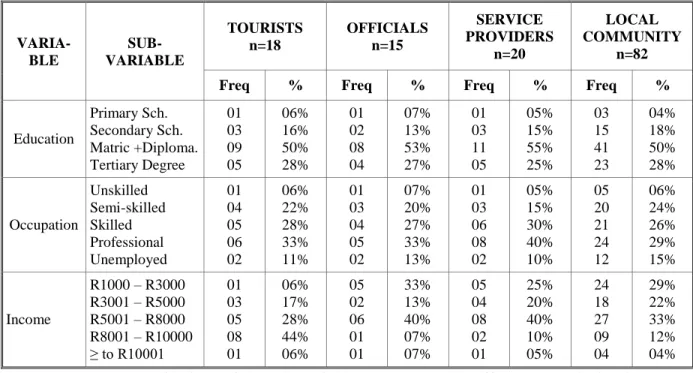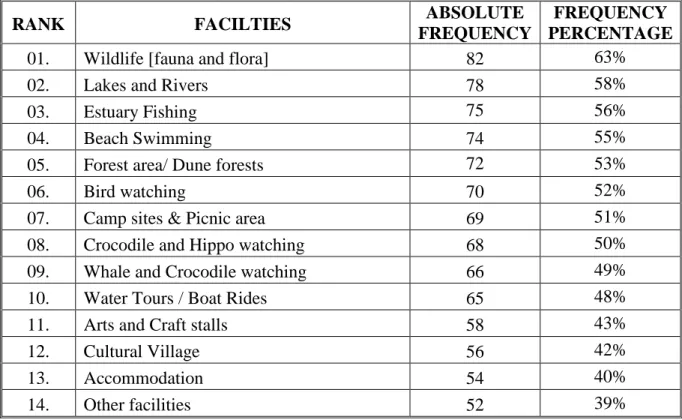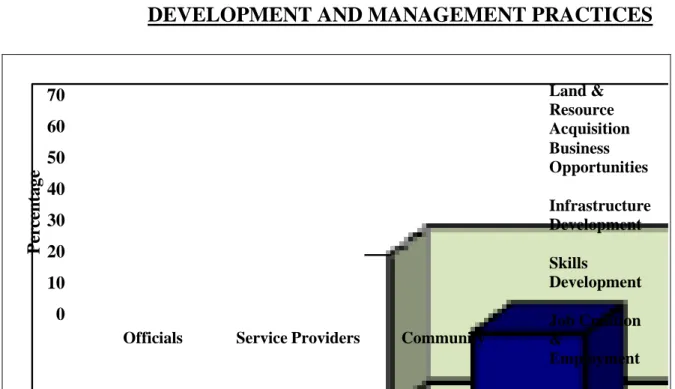To find out the extent to which stakeholders understand the meaning and importance of tourism development in the city of St Lucia. To find out if the coastal tourism resources in the study area are adequately supplied.
CHAPTER 1
INTRODUCTION
- BACKROUND INFORMATION
- THE PROBLEM STATEMENT
- THE RESEARCH QUESTION
- OBJECTIVES
- THE RESEARCH HYPOTHESES
- DELIMITATION OF THE STUDY
- Conceptual Delimitation
- Tourism
- Ecotourism
- Development
- The Coast
- Nature Conservation
- Commercialisation / Commodification
- Strategy
- Policy
- Practice/Practices
- Community
- SIGNIFICANCE OF THE STUDY
- ETHICAL CONSIDERATIONS
- RESEARCH METHODOLOGY
- Research Design
- Study Population
- The Sample
- Instrumentation
- Collection of Data
- Data Analysis and Interpretation
- Pilot study
- ORGANISATION OF THE STUDY
The study is interested in the accurate assessment of the properties of the above components. Furthermore, the researcher was successful in observing some of the activities that took place in the study area.
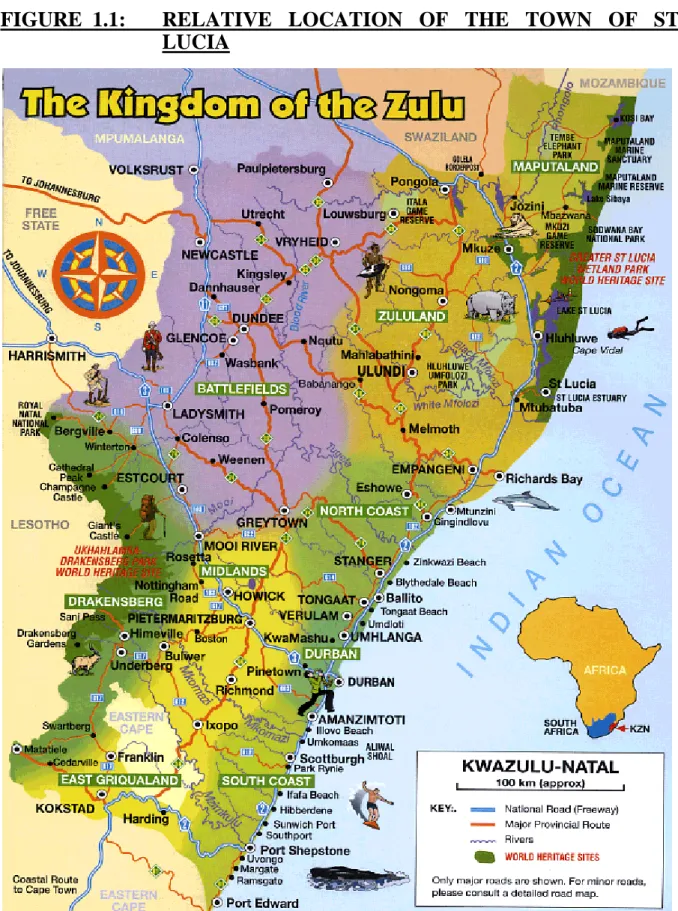
The orientation to the study serves as a prelude to other chapters and describes the overall character of the study. In other words, in this chapter a
Community leaders were contacted so that they could contribute to the preliminary pilot round of the questionnaire survey. Basically, there were no serious weaknesses recorded or observed in the structuring of the questions.
The theoretical framework focuses on some of the literature that relates to the study. This chapter reflects what other scholars or researchers in
The data analysis and interpretation of the study is presented in this chapter. More importantly the analysis of data is presented in the form of
CONCLUSION
Furthermore, the chapter also discussed the possible necessary policy changes to realize the development of ecotourism in the study area. Finally, the provision of tourism facilities is rooted in the shared responsibility for and commitment to the economic and social development of the municipality.
CHAPTER 2
INTRODUCTION
UNDERSTAND THE MEANING AND IMPORTANCE OF TOURISM
- Tourism Facilities
- Tourism Activities
It is therefore vital to promote ecotourism in the coastal areas of Saint Lucia and its surroundings. It is worth noting that the city of Saint Lucia and its surroundings, have many of the facilities listed above, including.
SUPPLY OF COASTAL TOURISM RESOURCES
- Supplying of Tourism Infrastructure
- Supplying Support to Emerging Tourism Businesses
The main difficulty in tourism, particularly in South Africa, is the scarcity of up-to-date and relevant research information. In the province of KwaZulu-Natal, many municipalities play a prominent role in providing tourism facilities.
TOURISM MANAGEMENT AND DEVELOPMENT STRATEGIES
Lodging is one of the oldest industries in the history of tourism and continues to be one of the mainstays of the tourism industry. One of the leading and important practices in tourism, all over the world, is the guarantee of safety and security for tourists visiting a country.
ECOTOURISM: ITS NATURE AND DEVELOPMENT
It is important to treat visiting tourists with care as these customers often change their mind about a particular product. It is therefore important that this practice is standardized across South Africa as a whole (Halloway, 1999; Cooper et al, 2000; McIntosh, et al, 2002).
TOURISM DEVELOPMENT AND AUTHORITIES
Looking at the tourism development around the town of St Lucia and surrounds which is part of the Ezenvelo KwaZulu-Natal Wildlife, very little has been done in terms of local tourism development that promotes community participation. For example, the transport needs of Ezenvelo KwaZulu-Natal Wildlife can be outsourced to local communities.
TOURISM AND COMMUNITY DEVELOPMENT
The tourism industry must benefit the local communities, these benefits are derived from the tourism industry and promote community development. Fennel (1999) emphasizes the principles that must be followed to aid the collaborative efforts of the stakeholders.
CONSERVATION VERSUS COMMERCIALISATION
- Conservation Policy
- Ecotourism and the Natural Environment
- Sustainability of Natural Resources
Ecotourism and the natural environment are closely related concepts and cannot be treated independently of each other. The concept of sustainability has come to mean the need to preserve and protect the natural environment.
APPLICATION ON TOURISM DEVELOPMENT POLICIES
- Tourism Policy, Laws and Regulations
- Policy and the Government Structure
- Tourism and Variety of Policies
- Implementation of Tourism Policies
- Tourism Planning and Policies
The formulation of tourism policy is the essential responsibility of the government that wants to develop tourism as an integral part of its economy. The nature and type of policies developed and implemented vary according to the size and nature of the enterprise.
TOURISM AND COMMUNITY DEVELOPMENT
A person can benefit from tourism by being employed in tourism, or by providing ancillary services to the tourism industry, or by being tourists themselves. The policy frameworks that identified weaknesses or “failed opportunities” in the industry include the following: (a) insufficient funding directed towards recreation and tourism; b) insufficient education and training in leisure and tourism; (c) limited community involvement; d) ineffective safety and security measures and crime prevention; and (e) the lack of integrated national, provincial and local tourism development and management structures.
THE LOCAL COMMUNITY BENEFIT FROM ECOTOURISM
- Economic Empowerment and Industry Transformation
Infrastructure could include the construction of roads, electricity and sewage in a given area, especially if the area is rural. Ownership of the tourism industry in South Africa and many other developing destinations, particularly in rural areas, remains in the hands of established companies rather than the local community.
TOURISM BENEFITS FOR THE LOCAL COMMUNITY
- Economic benefits
- Non-economic benefits
- Personal benefits
- Societal benefits
Van Zyl (2002) non-economic and non-financial development benefits are worth considering based on the following initiatives: a) Extending capacity building and training within the community;. However, there are other types of societal benefits, including potential contributions to the development of larger communities and a higher level of public health.
CONCLUSION
First, social or communal benefits refer to the support and enhancement of intimate communities, those family and friendship groups that share a spatial habitat and common lifestyle. Such benefits can also be long-term, for example, as supporting conservation on an ecological basis for human life and contributing to the basis for social cohesion [http://www.psychclassics.yorku.ca/Maslow/motivation.htm.
CHAPTER 3
- INTRODUCTION
- HISTORICAL BACKGROUND
- PHYSICAL LAYOUT OF THE STUDY AREA
- Location of the iSimangaliso Wetland Park
- Location of Khula Village
- Eviction and Resettlements
- iSimangaliso Park Authority
- TOPOGRAPHY, HYDROLOGY AND CLIMATE
- Topography
- Hydrology
- General climate
- ECONOMIC AND CULTURAL ATTRIBUTES
- Infrastructure
- Accommodation
- Cultural Activities
- Craft work
- CONCLUSION
Some residents of Khula village work in the town of St. Lucia [C], working in homes, restaurants, lodges and shops. The surrounding areas of the city of St. Lucia and the iSimangaliso Wetland Park have been overshadowed by the negative history of evictions and resettlements.
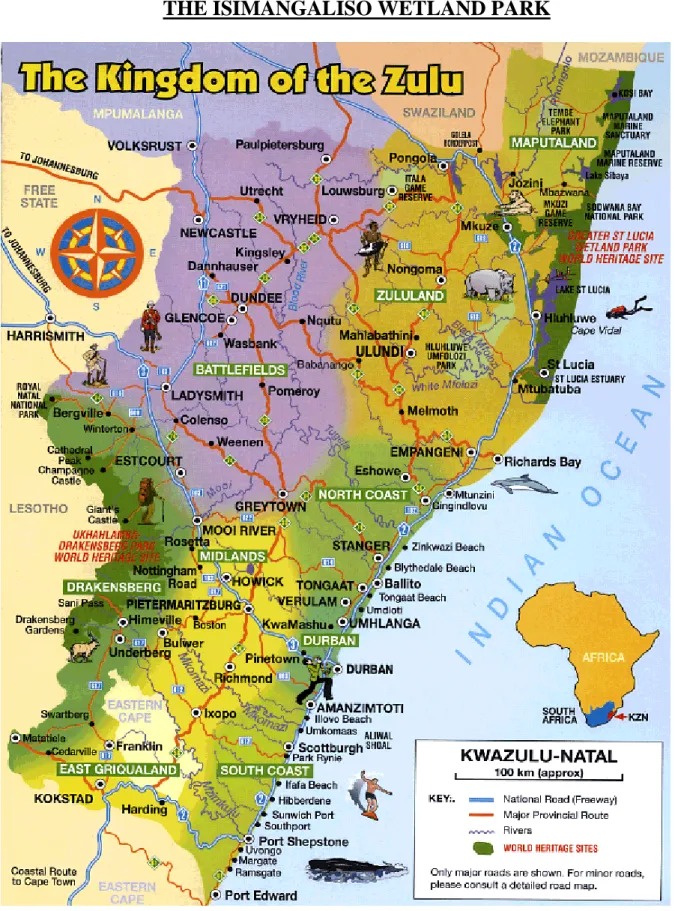
CHAPTER 4
INTRODUCTION
The results obtained from analysis and interpretation of data provide feedback on the tenability or feasibility of the original research hypotheses. However, it should be noted that even if the results of the analysis and interpretation are in agreement with the hypotheses, this does not necessarily mean that the theory has been definitively and irrefutably proven, but is only tentatively supported since there is no other theory that can support the results obtained. explain (Bless and Higson-Smith, 2000).
RESTATEMENT OF THE OBJECTIVES AND HYPOTHESES
What followed was the analysis and interpretation of data collected from 135 respondents in the study area. In other words, in this chapter the objectives of the study are thoroughly interrogated in conjunction with the data collected with a view to achieving the outcomes of this research.
DEMOGRAPHIC CHARACTERISTICS OF RESPONDENTS
- The Gender Variable
- Marital Status
- Education Qualifications
- The Occupation Variable
- Level of Income
A relatively small proportion of the members of the local community (18%) belonged to the elderly group (56-80 years). As Table 4.1 shows, the marital status of the respondents indicated that, on average, 51 percent of respondents in this survey area were married.
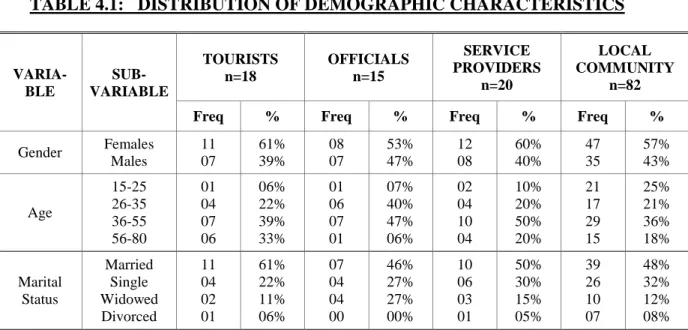
UNDERSTANDING OF THE MEANING AND IMPORTANCE OF TOURISM DEVELOPMENT
In light of these results, it can be concluded that hypothesis 1, which states: That the stakeholders have a good understanding of the meaning and importance of tourism development in the city of St Lucia, should be supported. On the other hand, 23 percent of respondents were wrong and 19 percent were not sure.
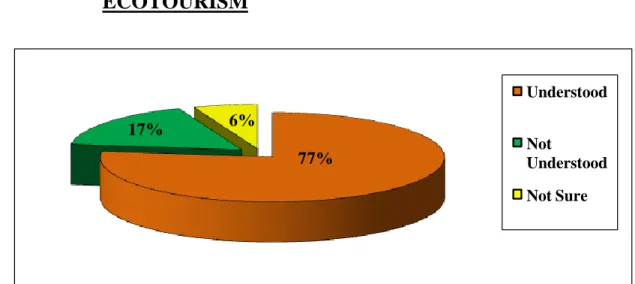
THE SUPPLY OF COASTAL TOURISM RESOURCES
On the other hand, the majority of service providers [47%] and the local community [41%] expressed the opinion that the offer of tourist facilities and activities in the study area was insufficient and 'unsafe', respectively. The majority of respondents [63%] perceive wildlife covering fauna and flora as the objects or resources of ecotourism listed and supplied in the study area.
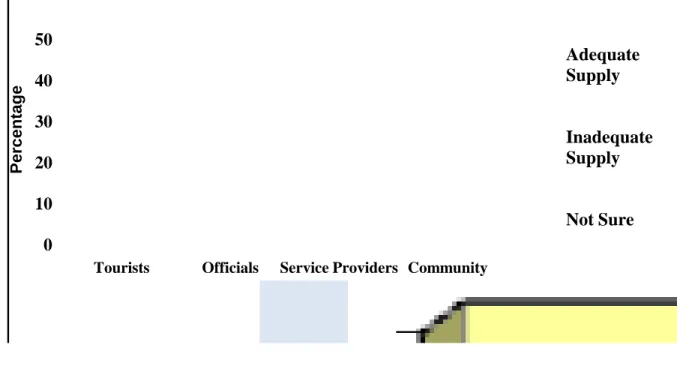
ECOTOURISM MANAGEMENT AND DEVELOPMENT STRATEGIES
- Awareness of Existing Ecotourism Management Practices
- Strategies Operating to Enhance Ecotourism Management
Ecotourism management or development strategies are important in the development and promotion of the tourism industry and related benefits. Apparently, there are too many ecotourism management strategies in the study area to be considered.
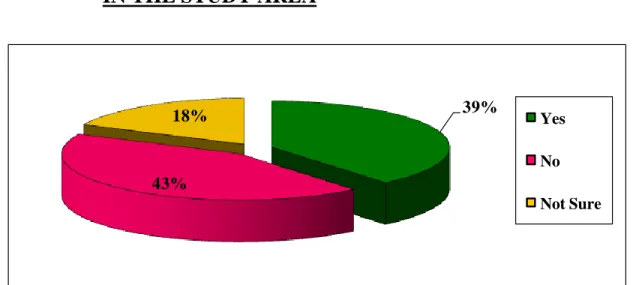
CONSERVATION VERSUS COMMERCIALISATION
The results of the survey are shown in Figure 4.5, where the majority of respondents [48%] indicated that they were in favor of maintaining the ecotourism resource conservation policy. On the other hand, approximately 30 percent of respondents indicated that they favored the use of both policies: conservation and commercialization of ecotourism resources.
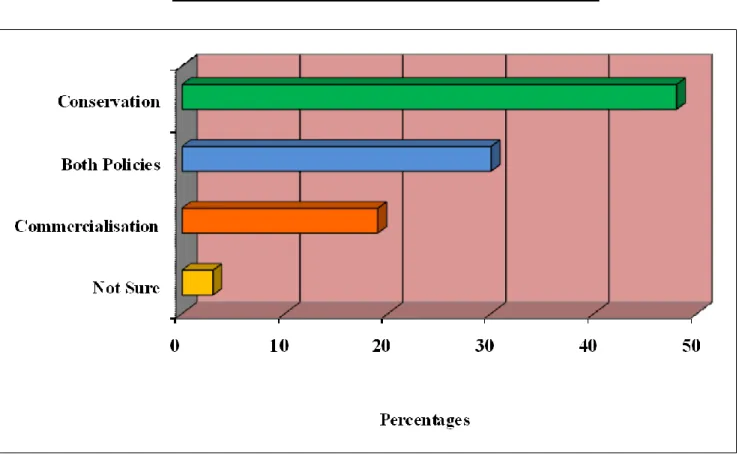
APPLICATION OF ECOTOURISM DEVELOPMENT POLICIES
- Awareness of Ecotourism Policies Promoting Development
- Existence of Ecotourism Policies in the Study Area
- Perceived Existence of Policies by Stakeholder Categories
On the contrary, about 29 percent of the respondents indicated that they were aware of ecotourism development policies that exist in the study area. Given the idea of the existence of ecotourism policies and practices in the study area, stakeholders were asked to indicate which ecotourism policies and practices they were aware of in the area.
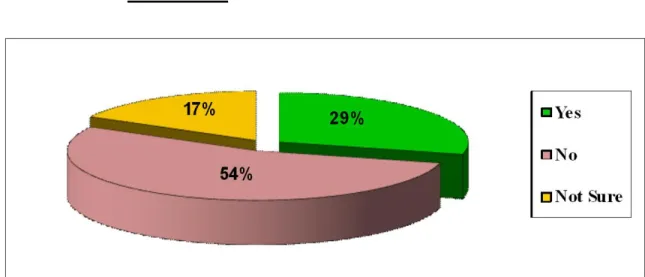
COMMUNITY BENEFITS FROM ECOTOURISM
- Perceived existence of ecotourism benefits
- Types of Ecotourism Benefits Available in the Study Area
The basis for this support is based on the finding that the majority of respondents considered the benefits of ecotourism to be available in the study area. What is shown in Figure 4.9 are the ranked benefits of ecotourism considered available in the study area.
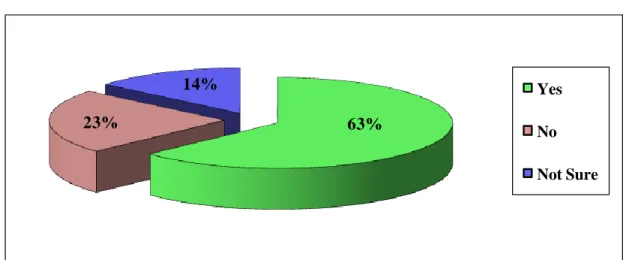
CONCLUSION
The justification for this finding is that many local communities are unemployed and always want someone to offer them a job. The latter is based on whether the local community could benefit substantially from either the conservation approach or the commercialization strategy in developing ecotourism.
INTRODUCTION
SUMMARY OF THE STUDY
The core of the study is the fourth chapter, which focuses on the analysis and interpretation of the collected data. Finally, the fifth chapter provides a summary and conclusions of the study based on the objectives and hypotheses.
CONCLUSIONS BASED ON OBJECTIVES
The findings of the analysis were that the majority of stakeholders indicated that they were not aware of the existing ecotourism management strategies in the study area. The basis for this support was based on the finding that the majority of respondents considered the benefits of ecotourism available in the study area.
RECOMMENDATIONS
The entire part of the conclusions based on the objectives, has addressed: the understanding of the meaning and importance of tourism development; provision of coastal tourism resources; the use of ecotourism management and development strategies; comparative analysis of the conservation principle versus commercialization [commodification]; the existence of ecotourism development policies; and the availability of ecotourism benefits to the local community. Based on the data interpreted in the previous chapter, recommendations have been made.
CONCLUSION
DEAT [Department of Environmental Affairs and Tourism] (1991): Draft White Paper on sustainable coastal development in South Africa. DEAT [Department of Environmental Affairs and Tourism] (1999): Draft White Paper on Sustainable Coastal Development in South Africa.
DEMOGRAPHIC VARIABLES 1. Gender
UNDERSTANDING THE MEANING & IMPORTANCE OF TOURISM DEVELOPMENT
11 Do you think it is important for the local community to develop and preserve tourism-related facilities.
Are you aware of any existing ecotourism management or development strategies in place in the St Lucia area. Please list the types of strategies that have been used successfully in the St Lucia area:.
ECOTOURISM DEVELOPMENT POLICIES IN AREA
Who do you think should be responsible for establishing policy in the St Lucia area.
COMMUNITY BENEFITS FROM ECOTOURISM
All information collected from you through the interviews or questionnaire will be kept strictly confidential.
